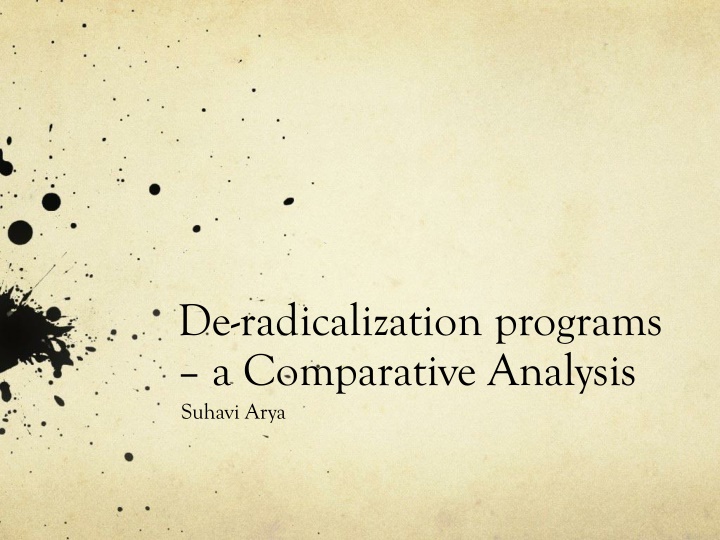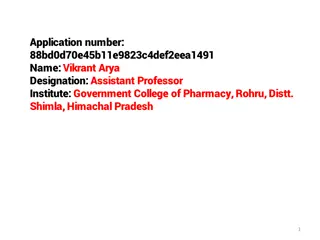
Comparative Analysis of De-radicalization Programs: Success and Challenges
Explore the effectiveness of de-radicalization programs worldwide, including Saudi Arabia, focusing on counseling, behavioral analysis, and online interventions. Discover the impact on religious, psychological, and socio-economic aspects. Evaluate success rates and re-integration efforts in countries like Pakistan and Denmark, alongside recent initiatives in the United States to counter terrorism through civic engagement.
Download Presentation

Please find below an Image/Link to download the presentation.
The content on the website is provided AS IS for your information and personal use only. It may not be sold, licensed, or shared on other websites without obtaining consent from the author. If you encounter any issues during the download, it is possible that the publisher has removed the file from their server.
You are allowed to download the files provided on this website for personal or commercial use, subject to the condition that they are used lawfully. All files are the property of their respective owners.
The content on the website is provided AS IS for your information and personal use only. It may not be sold, licensed, or shared on other websites without obtaining consent from the author.
E N D
Presentation Transcript
De-radicalization programs a Comparative Analysis Suhavi Arya
De-radicalization in Saudi Arabia Reportedly, 2500 Saudis have gone to Syria to fight for ISIS. Prior to that many have traveled to Afghanistan to wage a war against the Soviets. A program to de-program jihadist radicals was established. They claimed to have high success rate, however Two-pronged, in prison and online
Stages of de-radicalization programs Counselling in prison; Analyze their behavior and provide therapy accordingly; Made to pass an exam to show that they have given up on extremist ways; 8-12 week rehabilitation program at a halfway house.
Sakinah Campaign Radical groups use internet to disseminate their ideologies Rate of it is 60% Attempt to reverse internet - radicalization Religious scholars with the help of the Ministry of Islamic Affairs contact supposed radicalized persons online. Successful with 690 people
What did the program target? Religious convictions, psychological states, socio-economic positions, family groups, and even romantic lives
Success? In 2007, a member of the program declared that 90% of the participants had renounced their radical views 35 cases of recidivism out of the 1500 people who had passed from this program. Most important example being Said al-Shihri, who was released in 2007 and he orchestrated the bombing of American embassy in Sana a in 2008 Terrorist activities of 11 graduates was discovered in 2009
Re-integration Countries like Pakistan and Denmark focus of re- integration. They provide jobs, health care and mentorship. In Pakistan, the army is an integral part of the re- integration process.
In United States Only recently, a Minnesota District Court Judge initiated a program to counter terrorism. (March 2016) Heartland Democracy, a nonprofit from the city is handing this. Focusing on civic-engagement . Promoting how to be hybrid feel American and other culture(s).
In Singapore Replaced religious knowledge program with Civic and Moral education program Encouraged all religious communities to be represented in the Cabinet No religious community to represent a political community Mixed neighborhoods Personal Law was respected but Secular laws were upheld more Restricted external interference







